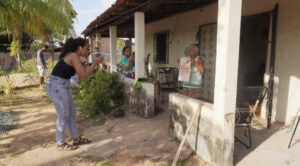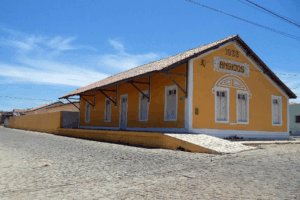Until recently, the town of Pedreiras, in northeastern Brazil, had no newspaper, radio station or local news site.
Best known in the state of Maranhão as the birthplace of the late samba singer João do Vale, it was also a “news desert,” a place devoid of consistent local journalism.
That changed in 2020 when four local journalists created the news website O Pedreirense, publishing investigations, opinion columns and video interviews. They become one of many digital outlets across Brazil that are transforming their regions from news deserts to oases of information.
“We try to give greater prominence to local populations in our reporting,” Joaquim Cantanhêde, executive editor of O Pedreirense, told LatAm Journalism Review (LJR).

Journalist Mayrla Frazão interviews Diocina Lopes dos Reis for O Pedreirense. (Photo: Courtesy O Pedreirense)
Northeast Brazil is the country’s region with the highest number of news deserts, according to the journalism census Atlas da Notícia (News Atlas), released this July. Nine of every 20 towns are news deserts, meaning almost 21 million people across Brazil have no access to journalistically verified information about their region.
Most outlets countering the tide are small and exclusively online. O Pedreirense operates with only three professionals who earn their living through grants and service contracts, Cantanhêde said.
“When we started, we wanted to do more fact-based production, which demands a high volume” of work, he said. “Today, we decide what we will cover in a more strategic way.”
The challenges of small city journalism
The town of Angicos, in the northeastern state of Rio Grande do Norte, became known across Brazil in 1963 when the educator Paulo Freire conducted an experiment teaching 300 people how to read within 40 hours. But the 12,000-population Angicos had been considered a news desert until this year.
Leonardo Ribeiro, who coordinates the portal Angicos Notícias, explains that he was able to expand distribution of content through partnerships with local radio networks.
“We started small and consolidated ourselves as the largest news initiative in the central region of the state, which covers 11 towns,” he said. Today, the team has eight staff members, including five columnists.
In addition to finding ways to reach potential audiences, local journalism needs good content to become relevant. And good stories can be found anywhere, Ribeiro said.
“It is up to the journalist to have a sharp instinct to spot story opportunities,” he said. “You have to have the desire to discover. In every town, there are scoops, whether because of important public works, bad government actions or the absence of action that harms the population.”

An old railway station in Angicos, a town in the state of Rio Grande de Norte that until recently was considered a news desert. (Photo: GLandovsky, CC BY-SA 4.0, via Wikimedia Commons)
Although the large Brazilian media conglomerates are located in the Southeast capitals, that region has the highest proportion of news deserts in proportion to the number of municipalities (49.76%), according to the News Atlas. In São Paulo state, journalist Eduardo Fálico runs the Portal da Cidade in the town of Bady Bassit, which also left the list of deserts this year.
When Fálico arrived in the town almost two years ago, the approximately 27,000 residents had not seen a local news outlet for nearly a decade. Today, the site’s team—three people, including Fálico, one intern and one sales person—works hard to provide daily coverage on politics, health and public services.
“The biggest challenge is to exist as a news outlet in a place where people and authorities are not used to the presence of journalism,” Fálico said.
“Knowing your audience is key”
Producing journalism is not enough to keep a news outlet alive. It is necessary to find sources of funding that allow operations to be maintained and also grow.
A survey by the project Mais pelo Jornalismo (More for Journalism) revealed in March 2025 that more than 2,000 news outlets have shut down in Brazil since 2014. The News Atlas census also showed that although digital media is growing, it is not immune to the crisis that is affecting journalism globally. At least 651 online outlets registered in the study have already closed, including 334 from 2023 to 2025.
“We do useful work for the community. The main challenge is monetizing,” said Fálico of Portal da Cidade. “Here, we had to do a big job of educating local advertisers about the importance of journalism in order to get support. Of course, the dream of every journalist is not to depend on public money, but it ends up being a path to stability.”
Cantanhêde said it was necessary to offer consulting services, such as public relations, as a way to ensure financial sustainability for the outlet. “We always do it taking the greatest care so that this does not interfere with the editorial independence of our journalism,” he said.
In terms of content distribution, social media helps engage audiences, but Cantanhêde of O Pedreirense said he believes it is important to go beyond algorithms. “To do local journalism, you have to know your audience very well,” he said. “It is an eager, dynamic audience. It is necessary to maintain real involvement with the community and to participate in your city’s events and programs.”
Mariama Correia is a journalist and coordinates research for the News Atlas in Northeast Brazil.